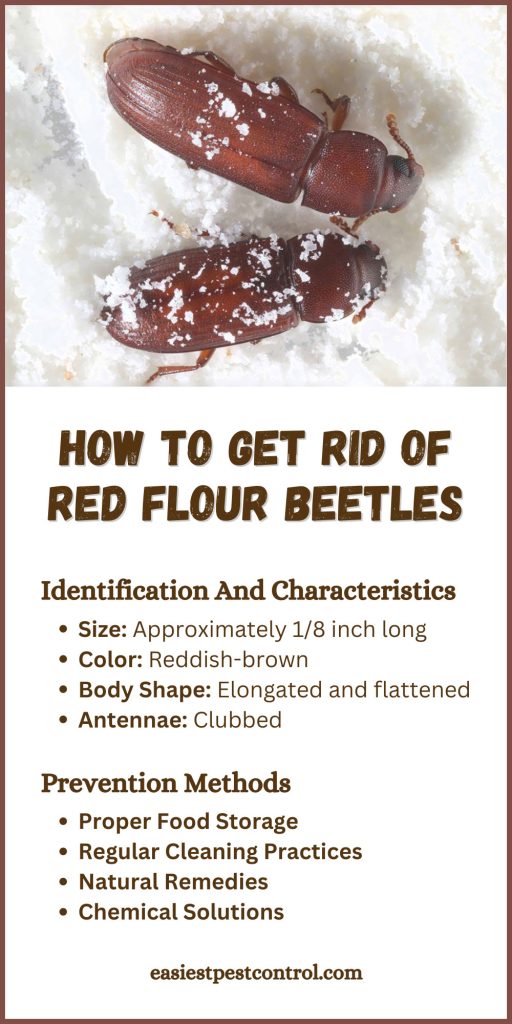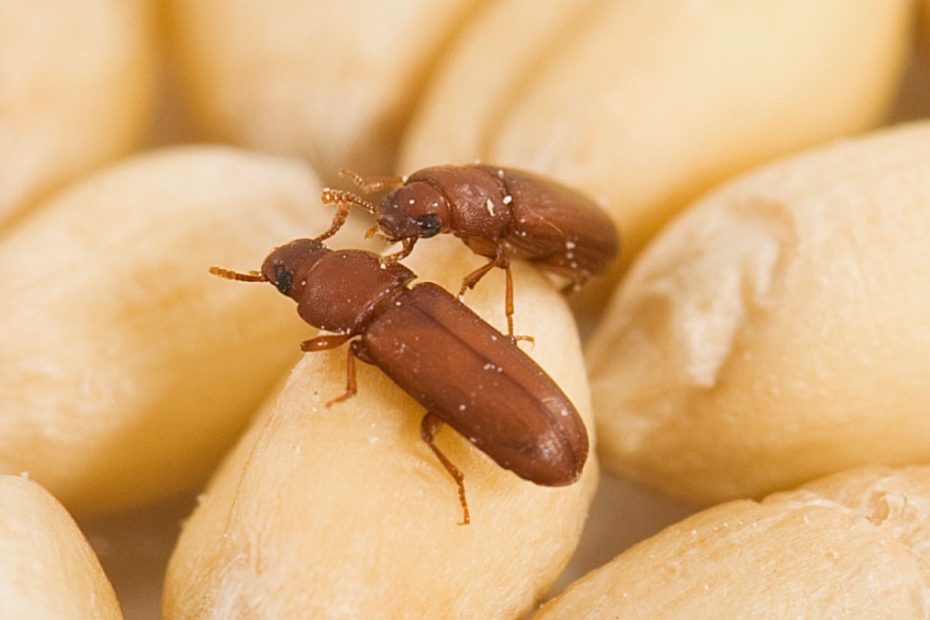Red flour beetles can turn your pantry into a nightmare. These tiny pests thrive in dry food products like flour, cereal, and pasta, making them a common household nuisance. If you’ve discovered these unwelcome guests, you’re likely wondering how to eradicate them quickly and effectively.
Don’t worry, dealing with red flour beetles doesn’t have to be a challenging job. With a few strategic steps, you can reclaim your kitchen and prevent future infestations. Let’s jump into the most effective methods for getting rid of red flour beetles and ensuring they don’t come back.
Key Takeaways
- Identify Red Flour Beetles: Recognize their distinct characteristics such as reddish-brown color, elongated bodies, and clubbed antennae, and understand their lifecycle to manage infestations effectively.
- Proper Food Storage: Use airtight containers made of glass or heavy plastic for storing dry food products, label and rotate items, and inspect new purchases to prevent infestations.
- Regular Cleaning Practices: Maintain a clean kitchen by vacuuming regularly, wiping down surfaces, inspecting cracks and crevices, and disposing of contaminated food to deter beetles.
- Natural Remedies: Implement homemade traps using bay leaves, soapy water, or molasses, and use food-grade diatomaceous earth to naturally reduce beetle populations.
- Chemical Solutions: Utilize insecticides like residual, contact sprays, and dust insecticides or seek professional pest control services for persistent infestations.
- Long-Term Strategies: Prevent future infestations with consistent monitoring, proper food storage, kitchen cleanliness, environment control, and using monitoring tools such as sticky and pheromone traps.

Understanding Red Flour Beetles
Red flour beetles infest dry food products, causing nuisances in households. Identifying these pests and understanding their lifecycle aids in effectively eliminating them.
Identification And Characteristics
Red flour beetles have distinct features making them identifiable. They measure about 1/8 inch long, with a reddish-brown color. They possess flattened, elongated bodies and clubbed antennae. Key characteristics include:
- Size: Approximately 1/8 inch long
- Color: Reddish-brown
- Body Shape: Elongated and flattened
- Antennae: Clubbed
Examples of where you might find them include flour, cereal, and pasta containers. Knowing these traits helps you spot infestations early.
Lifecycle And Habitat
Red flour beetles have a lifecycle that facilitates rapid reproduction. An adult female lays hundreds of eggs in a lifetime. The lifecycle stages are:
- Egg: Laid in food sources, hatching in 5-12 days
- Larva: Feed for 4-5 weeks, growing and molting
- Pupa: Develop into adults over 1-2 weeks
- Adult: Live several months, continuing the cycle
Typical habitats include warm, humid areas with readily available food sources. Infestations occur in stored products like flour, cereal, and other pantry items. Regularly inspecting these items and maintaining clean storage areas are crucial to preventing infestations.
Prevention Methods
Preventing red flour beetle infestations requires consistent effort and strategic techniques. By focusing on proper food storage and regular cleaning practices, you can significantly reduce the chances of encountering these pesky insects.
Proper Food Storage
Ensuring that food is stored correctly can help prevent red flour beetles from infesting your pantry. Follow these guidelines:
- Airtight Containers: Store all dry food products, such as flour, cereal, and pasta, in airtight containers to prevent beetles from gaining access.
- Use Glass or Heavy Plastic: Opt for glass or heavy plastic containers, as these are more secure than cardboard or thin plastic bags.
- Label and Rotate: Label containers with the date of purchase and use older items first to ensure nothing remains stored for too long.
- Avoid Bulk Purchases: Only buy quantities you can consume within a reasonable time frame to minimize the risk of long-term storage infestations.
- Inspect New Purchases: Check new food products for beetles before adding them to your pantry.
Regular Cleaning Practices
Maintaining a clean kitchen environment plays a crucial role in preventing red flour beetle infestations. Carry out these regular cleaning practices:
- Vacuum Shelves and Floors: Regularly vacuum pantry shelves, floors, and corners to remove food debris and beetle eggs.
- Wipe Down Surfaces: Clean shelves and storage areas with a mild detergent solution to eliminate any remnants that could attract beetles.
- Inspect Cracks and Crevices: Pay attention to cracks, crevices, and hidden spots where beetles might hide or lay eggs.
- Dispose of Contaminated Food: Promptly discard any infested food items to prevent the spread of beetles to other products.
- Monitor and Inspect: Regularly check stored food and areas for signs of infestation and act quickly if you detect any beetles.
Adopting these prevention methods can help you maintain a beetle-free kitchen. By practicing proper food storage and consistent cleaning, you’ll reduce the likelihood of red flour beetle infestations drastically.
Natural Remedies
Natural methods can effectively eliminate red flour beetles without using harsh chemicals. These options are safe for both you and the environment while being relatively easy to carry out.
Homemade Traps
Homemade traps offer an economical way to manage red flour beetle infestations:
- Bay Leaves: Place bay leaves inside pantry shelves and storage containers. Beetles avoid them due to their strong scent.
- Soap and Water Traps: Fill a shallow dish with soapy water. Beetles are attracted to the water, but the soap prevents them from escaping.
- Molasses Traps: Mix one part molasses with two parts water in a shallow container. The sticky texture traps beetles when they attempt to feed.
Diatomaceous Earth
Diatomaceous earth (DE) provides a natural yet potent solution against red flour beetles:
- Application: Sprinkle DE in pantry cracks, along shelves, and around food storage containers.
- Mechanism: DE is abrasive and dehydrates beetles by absorbing their oils and fats, leading to their death.
- Safety: Use food-grade DE only, ensuring it’s safe for use around food and pets.
Deploying these natural remedies can significantly reduce red flour beetle populations in your kitchen.
Chemical Solutions
To effectively eliminate red flour beetles, chemical solutions can be an efficient option. Consider these methods for comprehensive beetle control in your kitchen.
Insecticides
Using insecticides specifically designed for red flour beetles can significantly reduce their population. Here’s what you need to know about these chemicals:
- Types of Insecticides:
- Residual Sprays: These sprays leave a lasting residue that continues to kill beetles over time.
- Contact Sprays: These should be applied directly onto the beetles for immediate results.
- Dust Insecticides: Effective in cracks and crevices where beetles may hide.
- Application Methods:
- Follow the manufacturer’s instructions to ensure safe and effective application.
- Apply sprays in areas where beetles are commonly found, such as pantry shelves and cracks.
- Consider using dust insecticides for hard-to-reach areas.
- Safety Precautions:
- Always wear gloves and masks during application to avoid inhalation and skin contact.
- Keep food preparation surfaces covered and clean them thoroughly post-treatment.
- Ventilate the treated areas to clear any residual chemicals.
Professional Pest Control
If infestation persists even though using insecticides, professional pest control services can provide a thorough solution.
- When to Call Professionals:
- Persistent infestations resist standard chemical treatments.
- Significant beetle presence disrupts daily kitchen activities.
- What Professionals Offer:
- Comprehensive inspections to identify and target infestation sources.
- Advanced treatments that might not be available to the general public.
- Long-term prevention strategies tailored to your specific situation.
- Choosing a Pest Control Service:
- Look for certified and licensed pest control specialists.
- Check reviews and ask for referrals to ensure reliability and effectiveness.
- Discuss the treatment plans and safety measures before proceeding.
By incorporating these chemical solutions, you can significantly reduce, if not entirely eradicate, red flour beetle populations and maintain a clean, pest-free kitchen.
Long-Term Strategies
Effectively managing red flour beetles requires long-term strategies to ensure infestations don’t reoccur. Implementing preventive measures and maintaining regular monitoring helps keep your kitchen pest-free.
Preventing Future Infestations
Taking proactive steps prevents future infestations and keeps your pantry safe.
Food Storage
- Store dry food in airtight containers made of glass or heavy plastic, reducing beetle access.
- Label and date pantry items, ensuring a first-in, first-out rotation to minimize risk.
- Inspect new purchases for signs of beetles before adding them to your pantry.
Kitchen Cleanliness
- Vacuum shelves, floors, and crevices, removing food debris that attract beetles.
- Wipe down surfaces regularly with a mild detergent to eliminate food spills.
- Ensure that trash bins have tight-fitting lids and are emptied frequently.
Environment Control
- Keep your kitchen dry; beetles thrive in humid environments.
- Use dehumidifiers if necessary to maintain low humidity levels.
- Seal cracks and crevices to reduce entry points.
Monitoring And Maintenance
Consistent monitoring and maintenance ensure that any infestation signs are addressed promptly.
Regular Inspection
- Schedule routine inspections of pantry items for beetles or larvae.
- Check corners, crevices, and behind appliances where beetles may hide.
Monitoring Tools
- Use sticky traps designed for crawling insects; place them near food storage areas.
- Consider pheromone traps that attract beetles, which help monitor their presence.
- Immediately discard any infested products to prevent beetles from spreading.
- Clean and disinfect storage containers before replenishing them with new products.
- Regularly update your food rotation system to ensure older items get used before newer ones.
By integrating preventive measures with vigilant monitoring, you can maintain a kitchen free of red flour beetles.
Conclusion
By following the strategies outlined in this guide, you can effectively manage and eliminate red flour beetles from your kitchen. Identifying these pests, understanding their lifecycle, and implementing proper food storage and cleaning practices are essential steps. Natural remedies and chemical solutions offer additional options for tackling infestations.
Remember, maintaining a clean and organized kitchen is your first line of defense. Regular inspections and proactive measures will help keep your kitchen beetle-free. With diligence and the right approach, you can reclaim your kitchen and enjoy a pest-free environment.
Frequently Asked Questions
What are red flour beetles?
Red flour beetles are small pests that infest dry food products like flour, cereal, and pasta. They are about 1/8 inch long, reddish-brown, with elongated, flattened bodies, and clubbed antennae.
How can I identify a red flour beetle infestation?
Look for small, reddish-brown beetles in your dry food products. Other signs include tiny beetle larvae, damaged food packaging, and a musty odor in your pantry.
What conditions do red flour beetles thrive in?
Red flour beetles prefer warm, humid areas with accessible food sources. Ensuring these areas are kept clean and dry is crucial for preventing infestations.
How can I prevent red flour beetle infestations?
Store dry food in airtight containers, regularly clean pantry shelves and floors, inspect new food items before storage, and avoid buying in bulk to reduce the risk.
What natural remedies can eliminate red flour beetles?
Use homemade traps with bay leaves, soapy water, and molasses, or apply diatomaceous earth (DE), which is safe for food areas and pets.
Are chemical solutions effective against red flour beetles?
Yes, using insecticides like residual sprays, contact sprays, and dust insecticides can effectively eliminate red flour beetles. Follow application instructions and safety precautions carefully.
When should I call a professional pest control service?
Contact professional pest control if your infestation is severe or persistent. They offer comprehensive inspections, advanced treatments, and tailored long-term prevention strategies.
What long-term strategies can prevent future infestations?
Maintain proactive food storage practices, ensure kitchen cleanliness, control the environment, and use monitoring tools like sticky and pheromone traps to detect and prevent beetle infestations.
How often should I inspect my pantry for beetles?
Regularly inspect your pantry, ideally once a month, and immediately clean up any spills and discard contaminated food to prevent beetle populations from establishing.
Can red flour beetles harm my family or pets?
Red flour beetles are not harmful to humans or pets but can contaminate food. Regularly clean and inspect food storage areas to keep these pests at bay.
